Explore null | Canon Latin America

RF 15-35mm f/2.8L IS USM
- RF 15-35mm f/2.8L IS USM
- Lens Cap E-82II
- Lens Hood EW-88F
- Lens Case LP-1222
- Lens Dust Cap RF
-
OVERVIEW
-
SPECIFICATIONS
-
ACCESSORIES
-
RESOURCES
-
SUPPORT
-
MISCELLANEOUS
Expand your field of view with the RF 15-35mm f/2.8L IS USM lens. This wide-angle, L-series lens is a dynamic addition to the EOS R series line-up, offering a bright f/2.8 maximum aperture and 15-35mm focal length that helps capture landscapes, architecture and other wide-angled subjects in full view. Equipped with Canon’s Nano USM technology for quiet and smooth focusing, and up to 5 stops* of shake correction, the RF 15-35mm f/2.8L IS USM allows for clear shots in a variety of lighting conditions — even at night or in dark settings. Experiment with different angles and perspectives, with a minimum focusing distance of 0.92 ft./0.28 m. For reliable performance during tricky weather conditions, this lens is expertly sealed around its panels, switch and lens mount to prevent water and dust from entering into the lens. When it comes to raising your photography game, turn to the RF 15-35mm f/2.8L IS USM to deliver impressive results.






Thanks to the large-diameter RF mount and short back focus design, the RF 15-35mm F2.8 L IS USM lens provides superb control over depth of field and the ability to maintain the same aperture throughout the zoom range. This is particularly helpful when shooting outdoors at dusk or in inclement weather, or indoors in dimly lit rooms.

Bright f/2.8 Aperture Standard Zoom RF L Lens
Thanks to its 16 elements in 12 groups and a 9-blade aperture system, the RF 15-35mm F2.8 L IS USM lens is capable of gorgeous, out-of-focus areas and soft backgrounds throughout its zoom range. Its f/2.8 maximum aperture permits shallow depth of field and delivers an incredible level of control over background blur. The RF 15-35mm F2.8 L IS USM lens helps you express the mood of your image, creating impact photos and videos.

The RF 15-35mm F2.8 L IS USM lens is designed to work in conjunction with an EOS R series camera, with both the camera and the lens sharing data to dramatically reduce camera-shake blur, regardless of the situation, whether shooting video or stills. With up to 5 stops* of stabilization, it delivers clear results.

* Based on CIPA (Camera & Imaging Products Association) standards. Testing performed at a focal length of 35mm using the EOS R camera.
The RF 15-35mm F2.8 L IS USM lens is equipped with Canon's NANO USM system which features a diminutive chip-shaped ultrasonic motor that's engineered to help deliver high-speed, smooth, precise and near-silent operation, during still image AF and smooth movie AF.
Featuring a minimum focusing distance of 0.92 ft. / 0.28 m with a maximum magnification of approx. 0.21x, the RF 15-35mm F2.8 L IS USM lens provides incredible versatility from nearly any distance. Whether you’re shooting videos, still images of nature, close ups, architecture or sports, the RF 15-35mm F2.8 L IS USM lens can easily provide stunning images with minimal distortion.
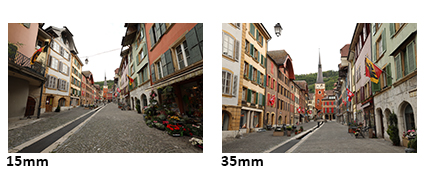
The RF 15-35mm F2.8 L IS USM lens has a separate, independent control ring that is located towards the front of the lens, which can be programmable for immediate exposure adjustments during still and video shooting. With the control ring, you can directly adjust numerous settings including shutter speed, lens aperture, exposure compensation and more. For photographers and moviemakers who would prefer a silent control ring, the clicking mechanism can be removed by a Canon service provider for a fee.
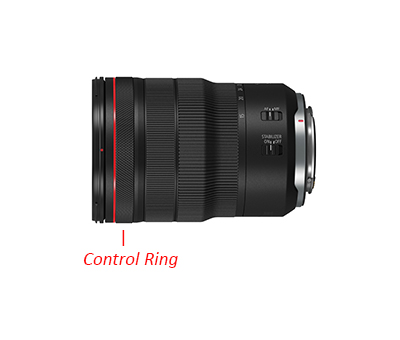
Designed to quickly process data, the RF 15-35mm F2.8 L IS USM lens features the 12 pin communication system inherent in all RF lenses. This accelerates AF, Image Stabilization, the Digital Lens Optimizer and more, helping to simplify complex operations and provide a quick and reliable user experience.
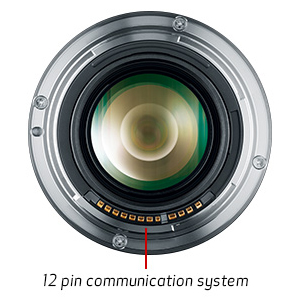
Lens Information Display
As part of the EOS R system, the RF 15-35mm F2.8 L IS USM lens works with an EOS R series camera so that its lens information is displayed right in the viewfinder, making it easy to confirm the lens's focal length without looking away from the subject at hand.
In-camera Digital Lens Optimizer
The EOS R system's 12 pin communication system enables the Digital Lens Optimizer, which works in-camera to combat aberrations and image deterioration, especially in the edges of the image frame when shooting at a large aperture. Data from the RF 15-35mm F2.8 L IS USM lens is transferred automatically to the camera body, facilitating near immediate correction for clear, detailed images.
Taking advantage of the RF mount, the RF 15-35mm F2.8 L IS USM lens offers incredible optical quality and a bright f/2.8 maximum aperture. Featuring 3 aspheric lenses for high image quality from center to corner and 3 UD lenses to help reduce aberrations for minimized distortion, the RF 15-35mm F2.8 L IS USM lens can deliver sharp images with reduced distortion in the edges of the frame and an overall improvement in image quality no matter the subject.
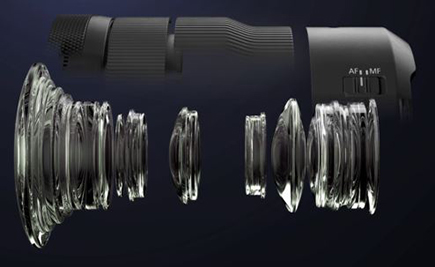
The RF 15-35mm F2.8 L IS USM lens features Canon's Air Sphere Coating (ASC), which significantly reduces the occurrence of lens flare and ghosting regardless of focal length or the angle of light. This helps provide clean results with minimal distractions and aberrations.
For reliable performance even when weather conditions get difficult, the RF 15-35mm F2.8 L IS USM lens features a dust- and weather-resistant construction in the lens mount, switch panel and all rings. Sealing is applied to lens joining sections, and switch panels to help prevent water and dust from entering into the lens.
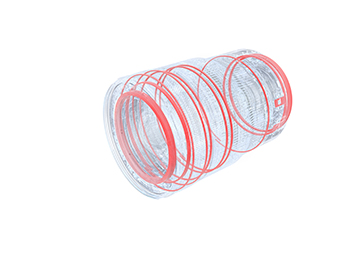
Fluorine Coating
Featuring fluorine coatings on the front and rearmost surfaces to help prevent dirt and dust from sticking to the lens, the RF 15-35mm F2.8 L IS USM lens makes it easy to clean smudges and fingerprints off.
High Reliability and Durability for Professional Use
The RF 15-35mm F2.8 L IS USM lens is built to endure the rigors of professional use. Constructed to be rugged, refined and precise, it can be operated intuitively so concentration can remain on the subject at hand.
Vibration Shock Resistance
Engineered to accommodate its optical system, the RF 15-35mm F2.8 L IS USM lens features L series level vibration shock resistance in the lens barrel, helping to maintain focus and settings even in turbulent situations.
* Based on CIPA (Camera & Imaging Products Association) standards. Testing performed at a focal length of 35mm using the EOS R camera.
| Focal Length Maximum Aperture | 15-35mm F/2.8 |
| Lens Construction | 16 Elements In 12 Groups |
| Closest Focusing Distance | 0.92 Ft./0.28 M |
| Filter Size | Ø82 Mm |
| Max Diameter X Length Weight | Approx. Ø3.48 In. / Ø88.5 Mm, Approx. 1.85 Lbs. / 840 G |
* Based on CIPA (Camera & Imaging Products Association) standards. Testing performed at a focal length of 35mm using the EOS R camera.

Lens Case LP1222
Lens pouch cases are compact, yet keep your lenses looking like new.

Lens Hood EW-88F
Lens hood that helps to block sunlight or other light sources to prevent glare and lens flare, as well as help protect the lens itself from scratches and the elements.

Lens Cap E-82 II
The Lens Cap E-82 II is newly designed and fits Canon EF lenses with a 82mm filter size. It helps protect the front glass from dust and scratches.

Lens Dust Cap RF
Helps protect the front glass from dust and scratches.
- Windows Server 2025
- macOS 15
- macOS 14
- macOS 13
- Windows 11
- macOS 12
- Windows Server 2022
- macOS 11
- Linux MIPS
- Linux ARM
- macOS 11.0
- macOS 10.15
- macOS v10.13
- macOS v10.14
- Windows Server 2019 (x64)
- macOS v10.14
- macOS v10.13
- Windows Server 2016 (x64)
- macOS v10.12
- Linux 64bit
- Linux 32bit
- OS X v10.11
- Windows 10
- Windows 10 (x64)
- OS X v10.10
- Windows Server 2012 R2 (x64)
- OS X v10.9
- Windows 8.1 (x64)
- Windows 8.1
- Windows Server 2012 (x64)
- Windows 8
- Windows 8 (x64)
- Windows 7
- Windows 7 (x64)
- Windows Vista
- Windows Vista (x64)
- Windows XP
- Windows XP (x64)
- Windows Server 2008
- Windows Server 2008 (x64)
- Windows Server 2008 R2 (x64)
- Windows Server 2003
- Windows Server 2003 (x64)
- Windows Server 2003 R2
- Windows Server 2003 R2 (x64)
- Windows 2000
- Windows NT
- Windows 3.1
- Windows Me
- Windows 98
- Windows 95
- Mac OS X v10.8
- Mac OS X v10.7
- Mac OS X v10.6
- Mac OS X v10.5
- Mac OS X v10.4
- Mac OS X v10.3
- Mac OS X v10.2
- Mac OS X v10.1
- Mac OS X
- Mac OS 9
- Mac OS 8
- Linux (x64)
- Linux (x32)
- Linux
- Not Applicable
Locating and Installing Your Download Cómo Localizar e Instalar su Descarga Localizando e Instalando seu Download
How to identify your OS version
To help determine which Windows operating system is running on your computer, please view the below steps:
Windows 11
Click on the Windows button (located left to the Search at the bottom).
Click on the Settings button to navigate to the system settings.
Scroll to the bottom of the page and click on the About button.
You will be able to find your Windows operating system under the Windows Specifications section.
Windows® 10
Click Start or click the Windows button (usually found in the lower-left corner of your screen).
Click Settings.
Click About (which is usually located within the lower left of the screen). The next screen should display the Windows version.
Windows 8 or Windows 8.1
Option1: Swipe in from the upper-right corner of the screen while viewing the desktop in order to open the menu, then select Settings.
Select PC Info. Under Windows edition, the Windows version is shown.
Option 2: From the Start Screen
While on the Start screen, type computer.
Right-click on the computer icon. If using touch, press and hold on the computer icon.
Click or tap Properties. Under Windows edition, the Windows version is shown.
Windows 7
Click Start or click the Windows button (usually found in the lower-left corner of your screen).
Right-click Computer and select Properties from the menu. The resulting screen should now display the Windows version.
Linux
To check the version of your Linux operating system (OS), you can use the following commands in your terminal:
1. uname -r: Displays your Linux kernel version.
2. cat /etc/os-release: Displays your distribution name and version.
3. lsb_release -a: Displays specific details about your Linux distribution and version.
4. You can also use the hostnamectl command to display the Linux kernel version. However, this command is only available on Linux distributions that use systemd by default.
To help determine which Mac operating system is running on your computer, select the Apple menu in the upper-left corner of your screen and choose About This Mac.
Upon selecting, you should see the macOS name followed by the version number.
Canon U.S.A Inc. All Rights Reserved. Reproduction in whole or part without permission is prohibited.